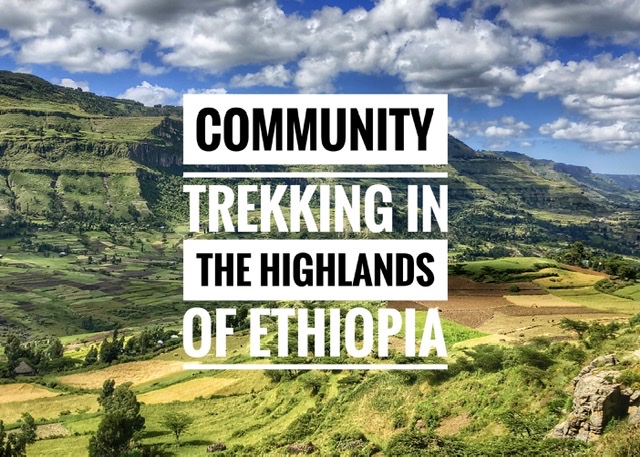
Trekking, as many may know, is one of our most-loved forms of travel and exploration. Trekking with meaning adds a whole new level. Back in 1996, a wonderfully innovative community oriented initiative called TESFA, meaning “hope”, was started in the Northern Ethiopian highlands. Nowadays, Tesfa Tours, runs multiple community trekking options using the TESFA program of community lodges, and we went on two of them. Once in the Lalibela (Wollo) region, and once again in the Tigray region (near Aksum). Although these treks were quite splurge for us ($1200 for both, 6 days/5 nights) we felt assured in the fact that at least 60-70% of that money was directly going back into the pockets and community coffers of the small villages who direly needed it. In return, the community members provided us with wonderful hospitality in comfy huts (with mattresses) to sleep in, as well as delicious home cooked and mostly locally sourced meals, and cozy campfires at the end of our long day of hiking.
Since beginning TESFA, has built about a dozen backcountry “huts” in some incredibly remote northern Ethiopian communities and strung them together with a network of old herding trails. Thus, building an opportunity for trekking in lands where it otherwise would be unattainable to most. The ownership of each “hut” was transferred to the community where it was built. These huts are theirs to manage and generate the much needed additional income to the village from trekkers like us. The villagers also benefit by learning valuable tourism and management skills.
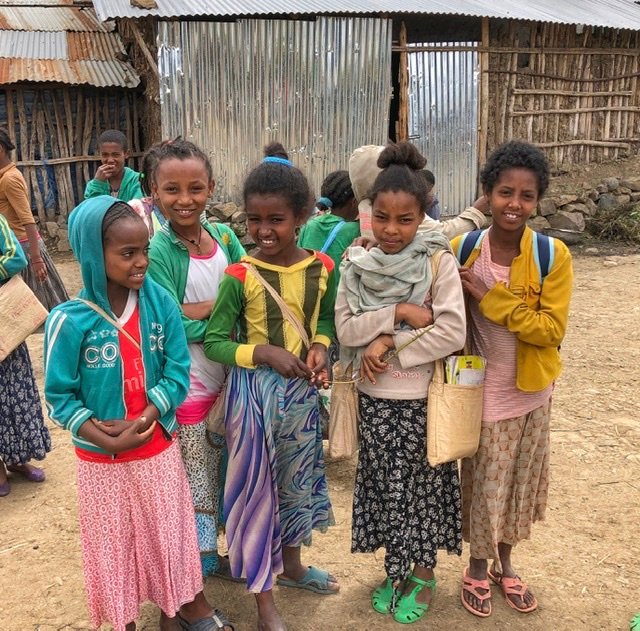
Lalibela Trek
As usual, we had a pack of children following us like puppies wherever we went. This squad was ready to send us on our departure down the trail.
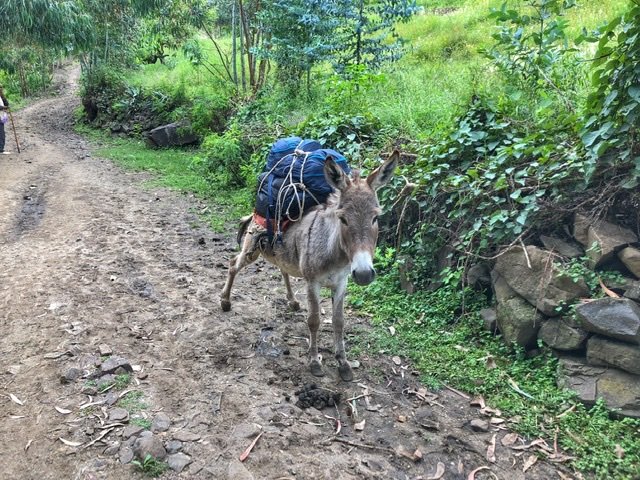
Meet Bala, our first, sweet mule (other than Greg) who trucked up our bags for us. Mandy was a bit disgruntled by the idea she was causing Bala discomfort, but Greg and our guide reminded her that our bag was only 20 lbs while she regularly carries 50. Shortly thereafter, she started running away from us sending the porter sprinting after her, when we caught up the porter exclaimed, “she thinks she’s free, because the load is too light.”
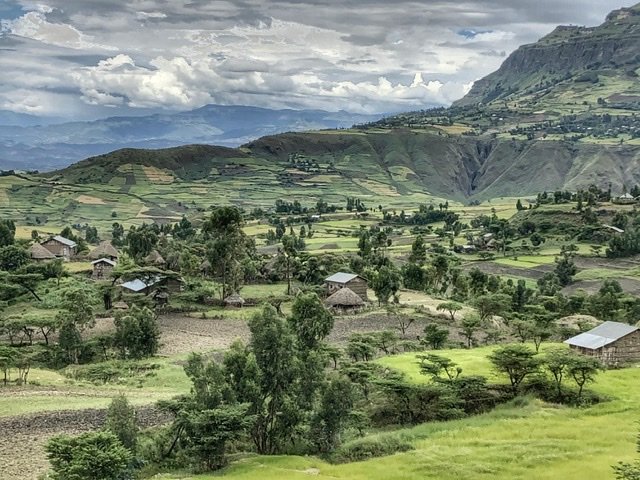
Walking through layers and layers of rolling green hills…unquestionably the most green we’ve seen since Albania.
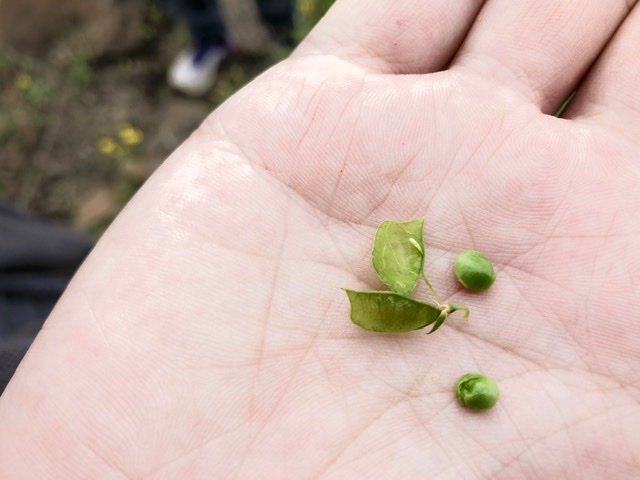
Guess which gassy little bean this is?! That’s right! Lentils in their rawest form can be plucked right off the ground! A bit bitter though when eaten straight.?
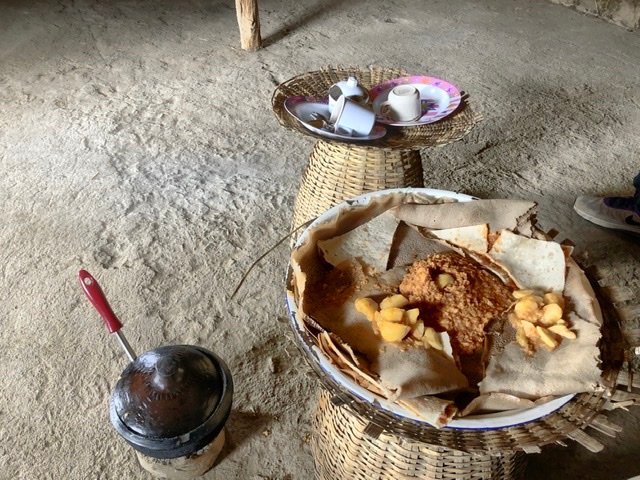
Speak of the legume! They’ve landed on our (giant) plate in the form of Shero Tegamino, where after hiking about two hours through gently rolling farmlands, across a few stream beds, and over some rocky outcrops we reached our first night’s accommodation.
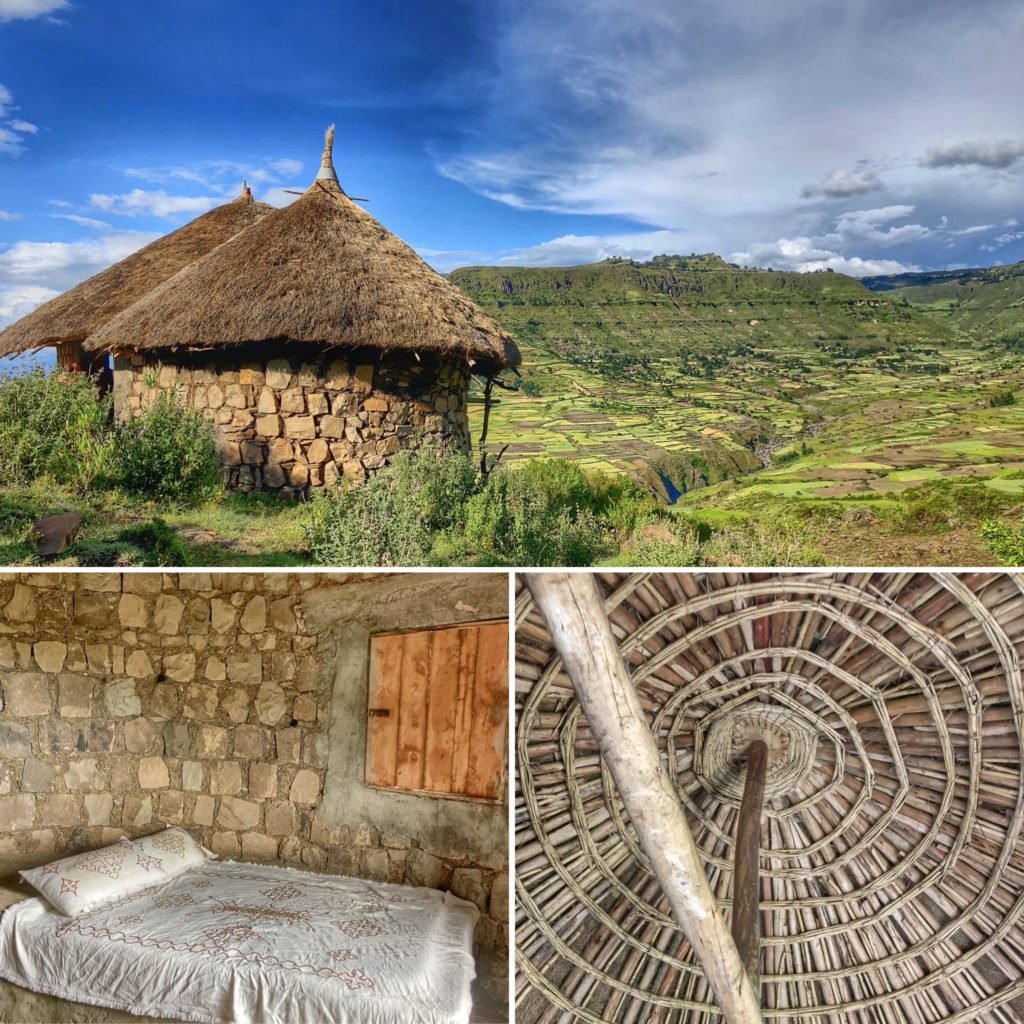
These well-built traditional stone and mud huts with roofs made of eucalyptus wood and straw thatch made for a cozy first night. At this point we were only about 2,200 meters in elevation so it wasn’t too chilly. But the views were already causing us to drop our jaws.

Sitting around the hut’s warming campfire at night. So peaceful. Just the right way to end a day’s hike. It was also here we got to know our wonderful guide Aregahgn, a bit more. The community staff members didn’t speak any English, so Aregahgn also served as a valuable translator. We learned they all live in the villages surrounding the camp year-round, but only have trekkers visiting the camp for about half the year. Most treks tend to start in October, making this the beginning of their season, but we were surprised to hear we were only their second group of the year. Dinner was a nourishing soup and a filling rice and vegetables that comfortably sent us off to sleep with full bellies.
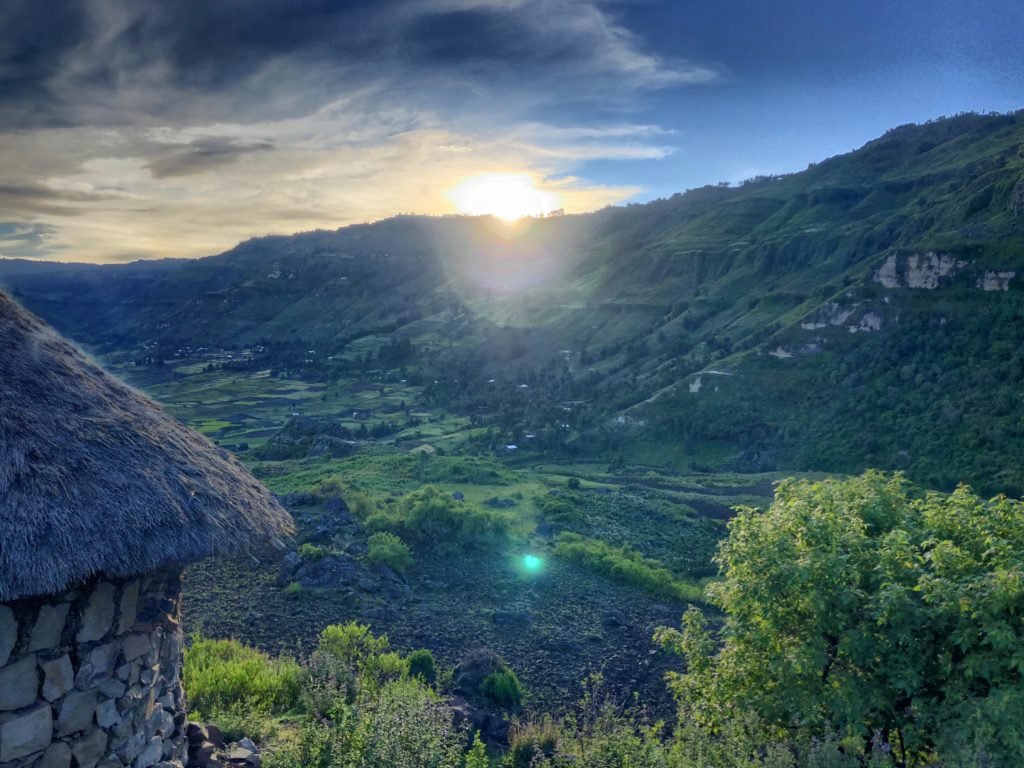
The next day after being awakened by the harmonic prayer chants playing over loudspeakers from a nearby village church, we enjoyed the sunrise as well as a simple, but tasty, breakfast of eggs and truly delicious local raw honey and bread. Oh, and of course several cups of locally grown and harvested Ethiopian coffee.

Our cooks…mother and daughter.
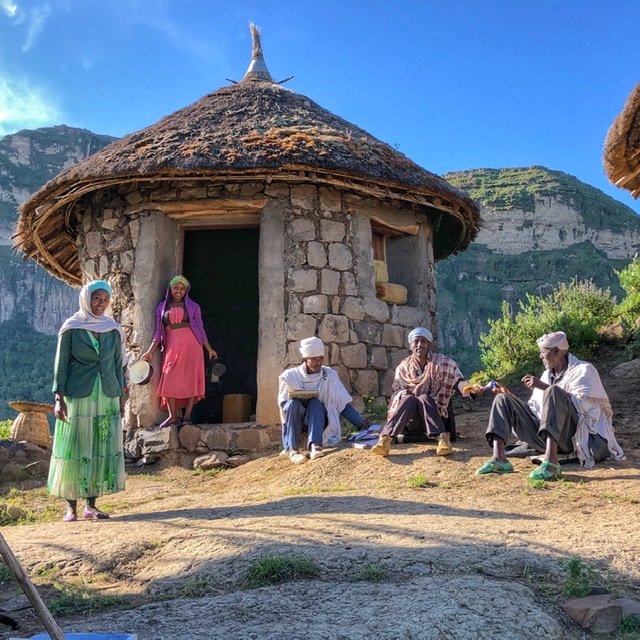
The whole gang!

After downing our coffee we packed up, and trudged uphill for a good three hours to the top of a rocky plateau. It is unbelievable how rugged, and green Ethiopia is. It’s just not the image most have of Ethiopia, including us. Walking in this epic landscape was beyond energizing! After a long ascent we stopped for a break on this plateau. Seemed like a decent spot to take advantage of having a guide available to take our picture.
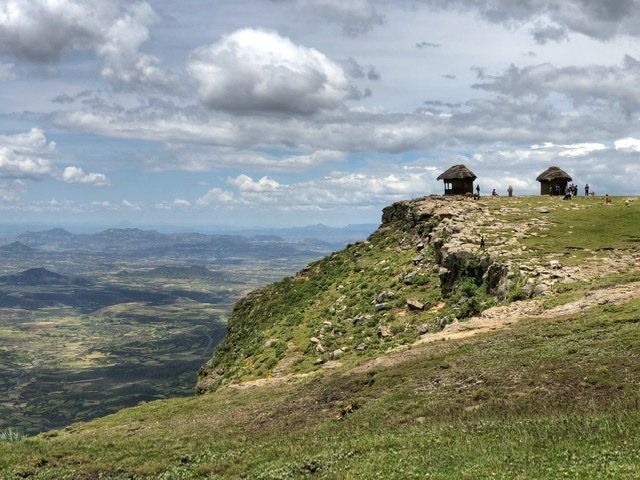
Heading up to our tasty lunch perch on the edge of a 2k foot escarpment.
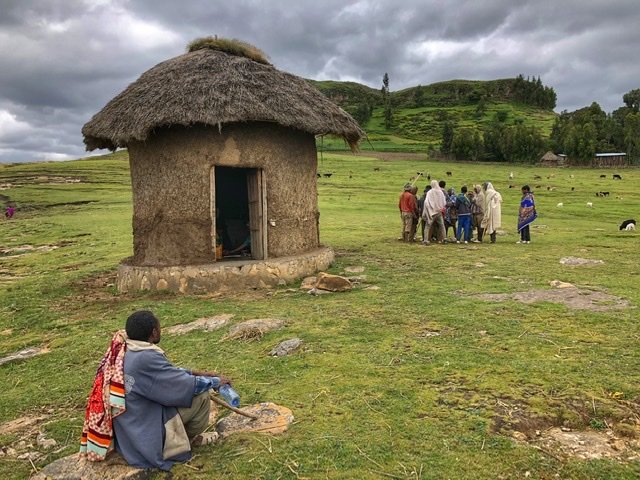
Lunch stop, day two was high atop a green plateau at about 3000 meters (9k ft.) The wind by now was wildly whipping and an ominous cloud made us apprehensive about what the next three hours would bring. Fortunately, the gusts kindly escorted the foreboding clouds in another direction and we escaped without a single raindrop. Our porter wrapped in his blanket, awaited us in the foreground…in his plastic shoes. All the porters had plastic shoes that were not far off from those 1980’s jelly shoes ? Imagine hiking for a living…wearing jellys.
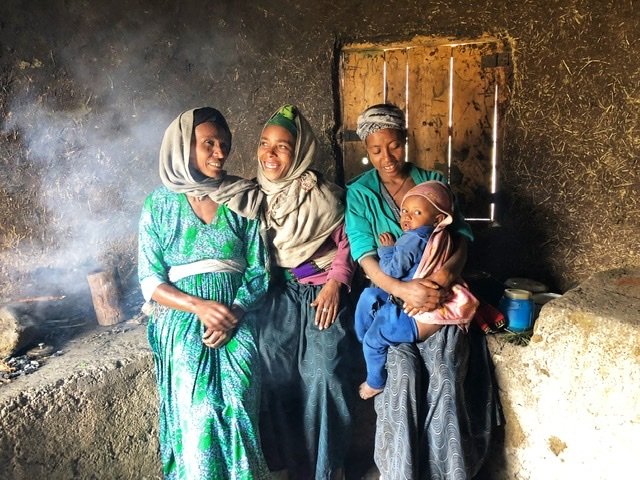
Living at an altitude of 3k meters (9k feet) these lovely girlfriends endure blustery winds and cold on a very regular basis. Like everyone we encountered on the trek, they seem to have no coats, but only wrap themselves in any layers they have and blankets for warmth, have little contact with the outside world and survive predominantly on what the land provides them. They prepared one of our lunches and coffee in this tiny hut using a fire on the floor. But their smiles say it all.
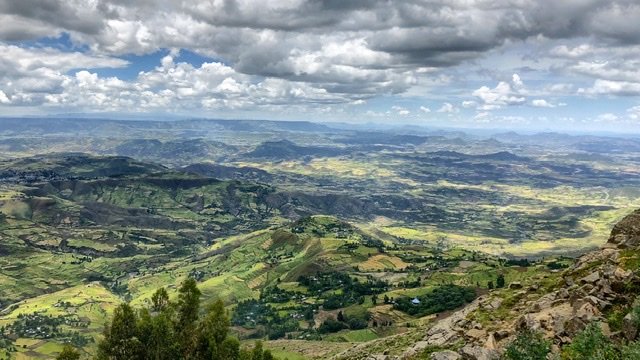
Lunch with an insane view! But first priorities. It was here Mandy revealed to our guide that she desperately had to wee. With no facilities, no trees to duck behind, and a small crowd who had assembled to see the faranjis eat, Aregahgn shooed away the onlookers as she got the experience of scrambling down on a ledge off the side of this cliff. Mandy vocally cursed men and their effortless ability to perform this most natural of processes, as she proceeded to coax a shy bladder into action as a boy on the nearby cliff rim started pointing at her and yelling “faranji!!” She relieved herself as genteelly as possible and climbed up from the cliff face.
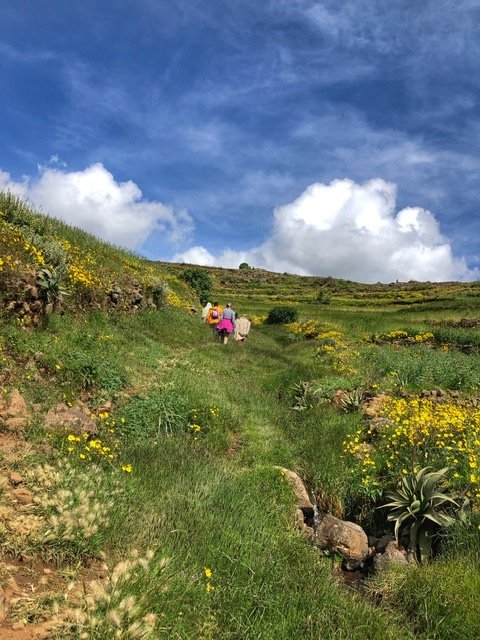
More rolling green as we continued our climb towards our hut for night two.
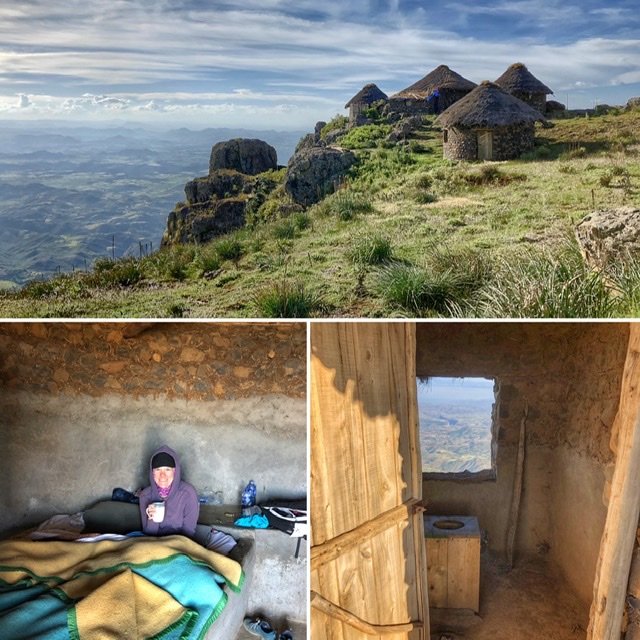
Arriving to our 2nd night’s accommodations, at an altitude that shocked us when we we told, 3400 meters (11,154 feet). Walking into the camp we were greeted with whipping winds and temperatures that dipped down to 8 degrees Celsius (46 F). But, oh, what an epic view! The camp couldn’t have been perched more dramatically. At least here Mandy had a proper toilet with a spectacular view to comfortably relax in. Also, our truly hospitable guide brought us coffee/tea in bed each morning around 7.
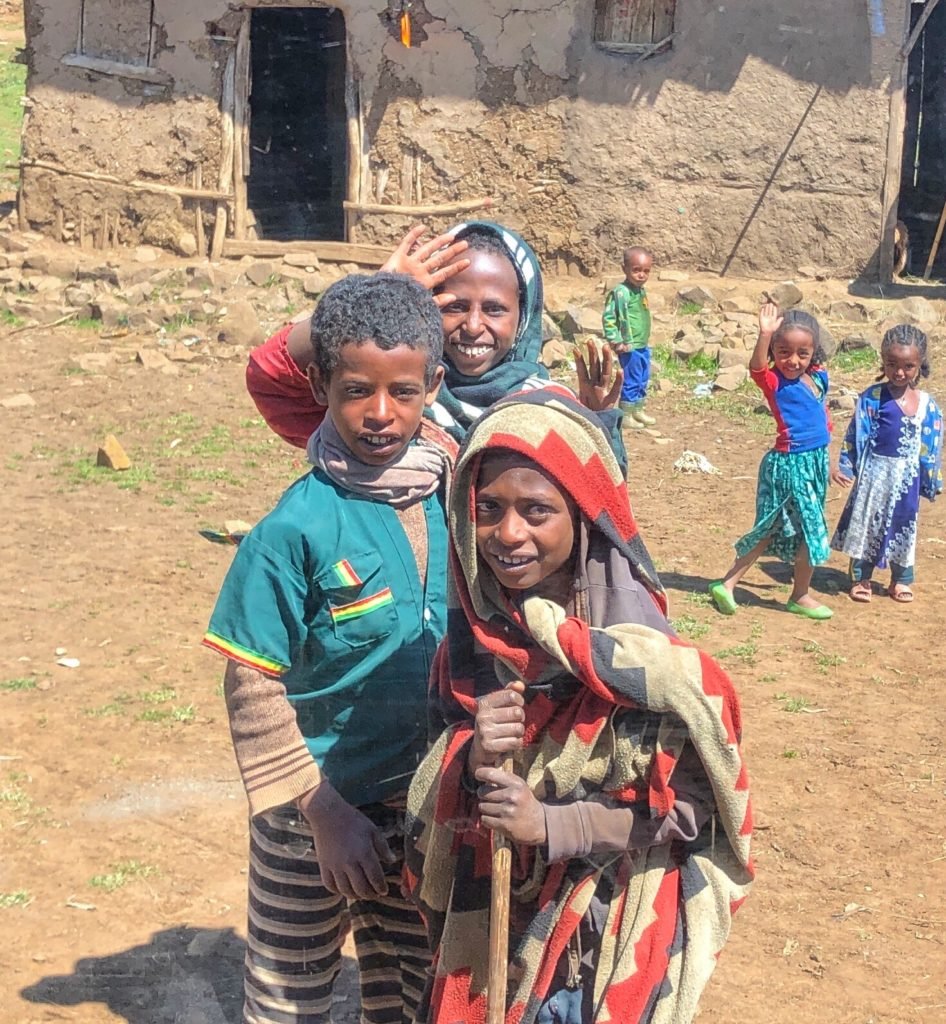
We ended our hike in a bigger village about three hours hike from our camp on the 3rd day. We were sent away with smiles and waves by the kids. Check out the little dolls in the background. Every time Mandy looks at this picture, she still giggles. If we ever adopted a kid, we’d take one of those two.
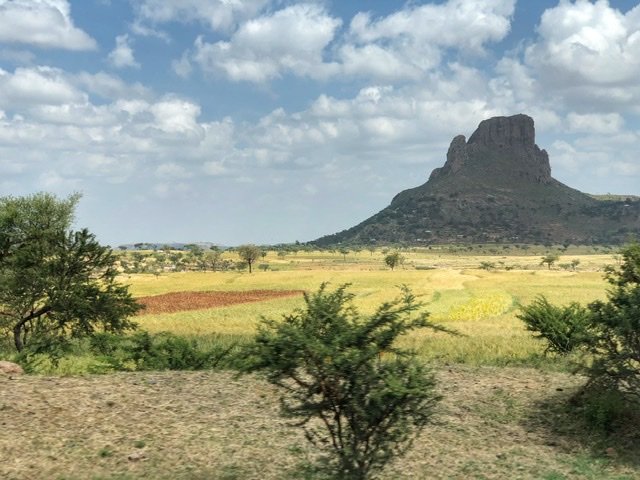
Tigray Trek
En route to our second trek from Aksum, we started seeing drastically changing landscape. Some of it even looked very similar to Monument Valley.
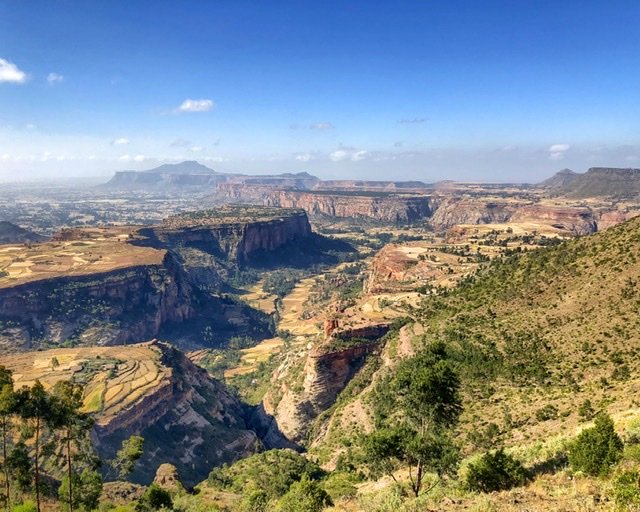
The second Tesfa trekking adventure was in the Tigray region of northernmost Ethiopia, a stones throw from the Eritrean border. And, it was quite unexpectedly very different than our first trek in Lalibela (Wollo region). The terrain was surreally reminiscent of the American Southwest, but the experience was unquestionably world’s away. On our trek we got paired up with some especially giddy and very upbeat porters who had a habit of dancing as much as walking, imbibed some strange brew in a tiny village, staggered into a frenzied bi-weekly market, and found serious comfort in mouthwatering homemade Ethiopian cuisine made over the fire and served with million dollar top-of-the-world views.
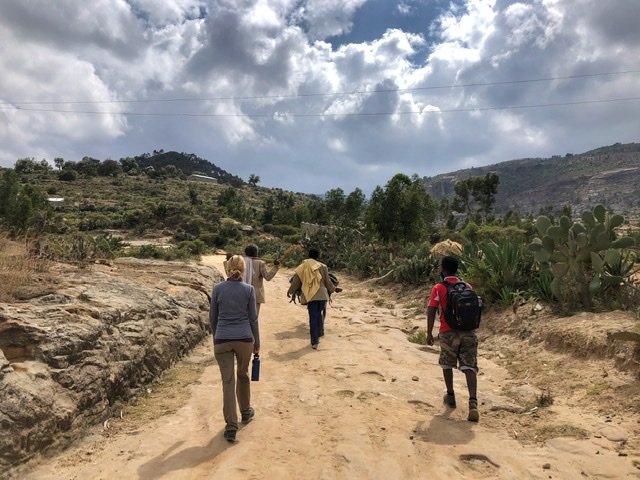
Day one was quick and easy, only about three hours of walking.

Arriving to our first community lodge, Mandy tries out the bed. They were definitely rustic, but cozy and comfortable. (But also don’t expect top notch cleanliness…We’re really not even sure that would be even possible in these circumstances. This is why we always carry our own sleep sheets and use our towels as makeshift pillowcase!)
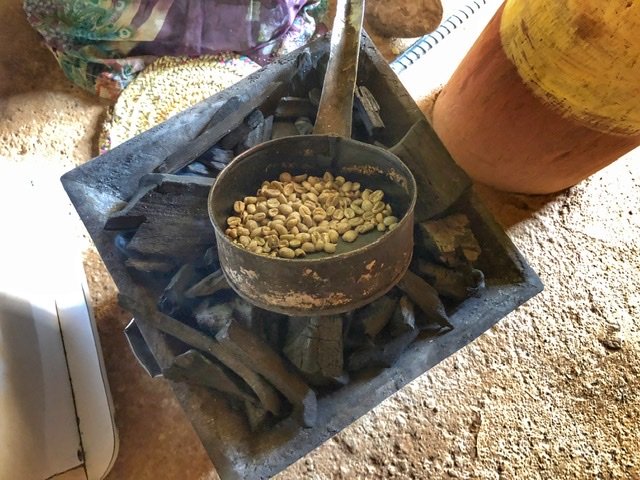
At all three lodges we stayed at included a traditional Ethiopian coffee ceremony experience. At the (60+ min.) ceremony, the cook will first roast green beans in a ladle over a small charcoal stove, continuously fanning the charcoal flames to keep them hot. Then, when the beans have become sufficiently blackened the still smoking beans are pushed under the noses of the guests, as you would allow the drinker to first sniff a wine cork for approval before imbibing, but rather than a whiff the sweet aroma of freshly roasted coffee we cannot help but gag on the smoke.
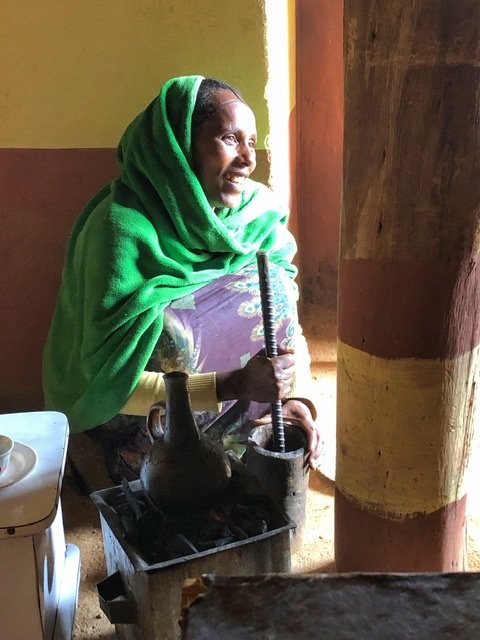
So, with a gagging nod of approval, the ceremony continues with the roasted beans being cooled and ground… the hard way! Mortar and pestle.

Once ground, we are again invited to judge, the grind (ah, much better.)
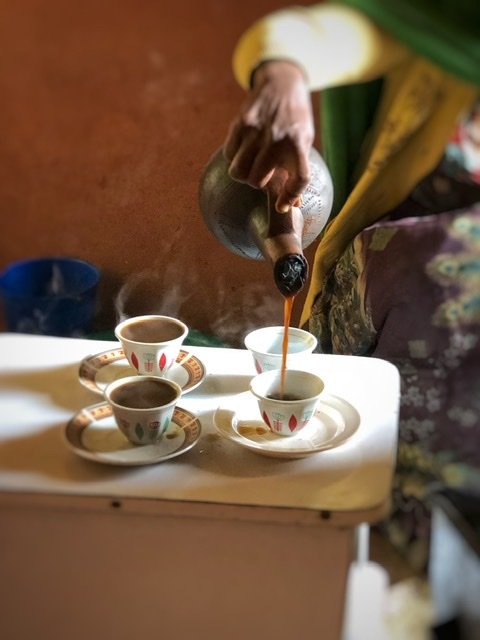
The ground coffee is then placed in a ceramic urn, with water, and placed on the coals to boil. That’s right, boil. To all you coffee drinkers out there… you can surely imagine and comprehend our wincing at about this point. But, that coffee was boiled, boiled, and boiled, and… massacred some more. At each boil point, a totally fascinating decoction method was performed where the boiling coffee (and grounds) was poured into a large cup, then poured back into the urn, and back and forth, back and forth, before returning the urn to the coals to be reboiled. This was repeated for probably 15 boil points. Then it was serving time. The first time we saw this process we were sure the coffee would taste like charcoal. But, to our shock…Out came some of the most delicious coffee we’ve had in our life. Screw Starbucks! Not an ounce of sugar or milk needed!!
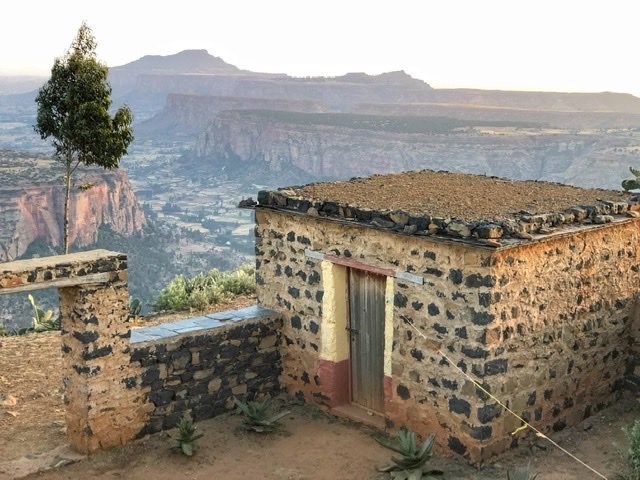
Unlike on the first trek, we stayed in more modern-looking lodges. It had a pit toilet, as well a solar fed shower, but considering it hadn’t been sunny at all that day, we weren’t going to experiment with such a contraption.
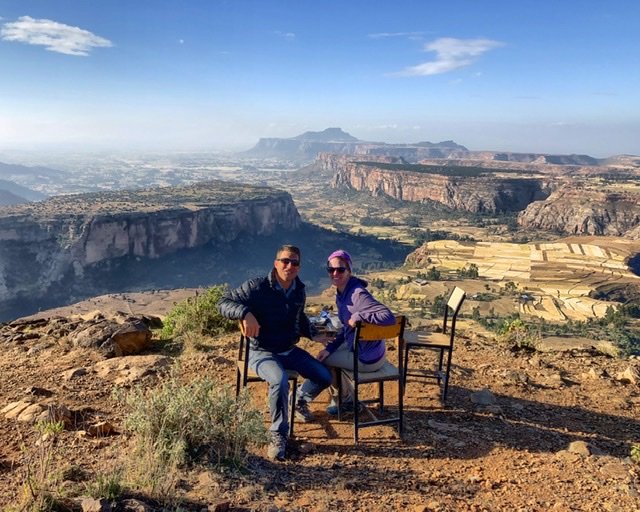
Top o’ the morning!! One of the most astounding views for breakfast imaginable. Like the previous trek, our breakfasts consisted of coffee/tea, eggs, and bread with honey so raw you could see the bee bits and pieces. Such a great way to start the day!
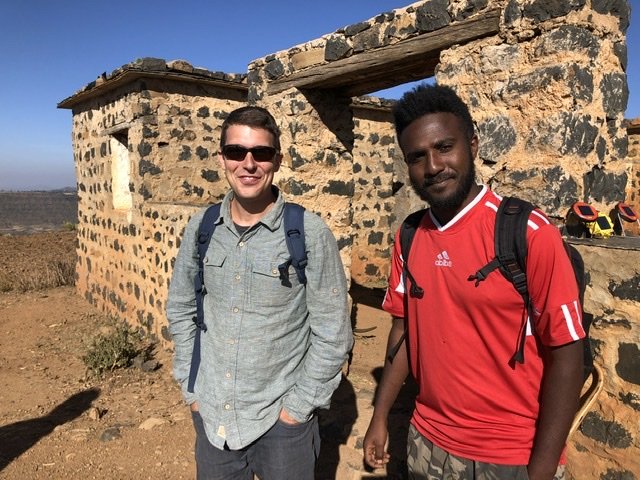
Greg and our terrific guide Solomon. Closely check out his shirt ? Ah, we love brand knockoffs! They’re the best!
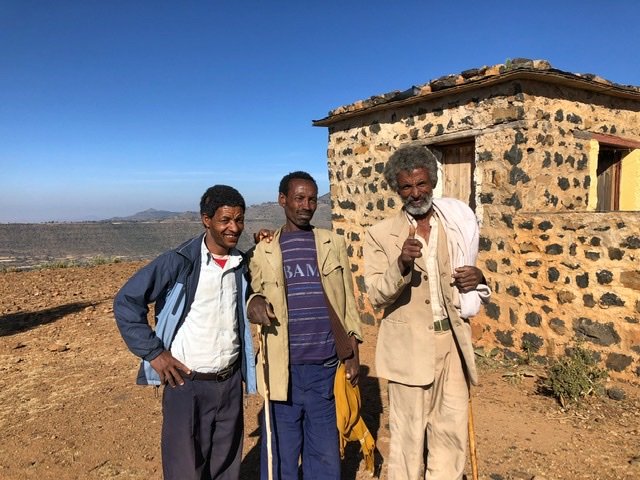
There was never a dull moment with our first porters, who danced (complete with Fred Astaire cane moves), sang, pantomimed, and laughed often. Naturally, we couldn’t understand a word they said but the entertainment was undeniable. Not to mention, they were very professional, down to their dapper attire!
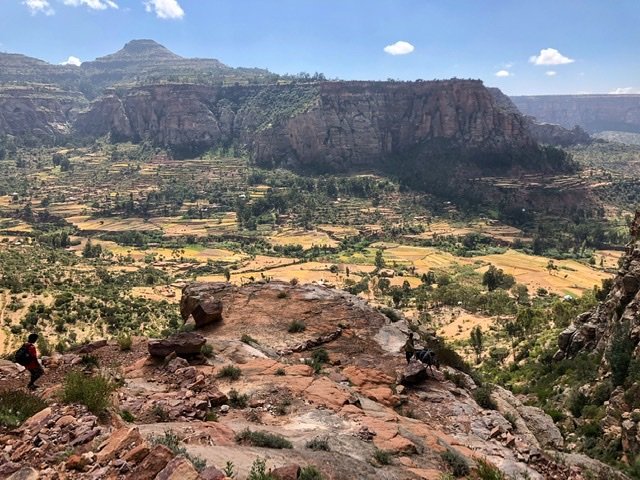
The hiking was simply spectacular… tabled plateaus of brilliant red rock cliffs that looked chiseled out of the landscape like an epic engraving dropped off into gaping canyons and grand valley floors. It’s like a mystical mixing of Zion meets Monument Valley National Parks.

On the trail. Four “staff” (use this term loosely as one was an ass), to two trekkers. Ah, at least we’ve provided jobs ?
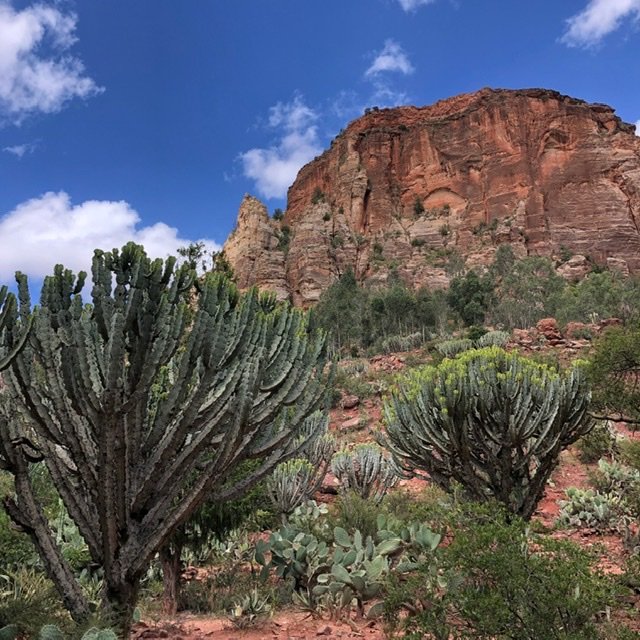
More and more beautiful views!
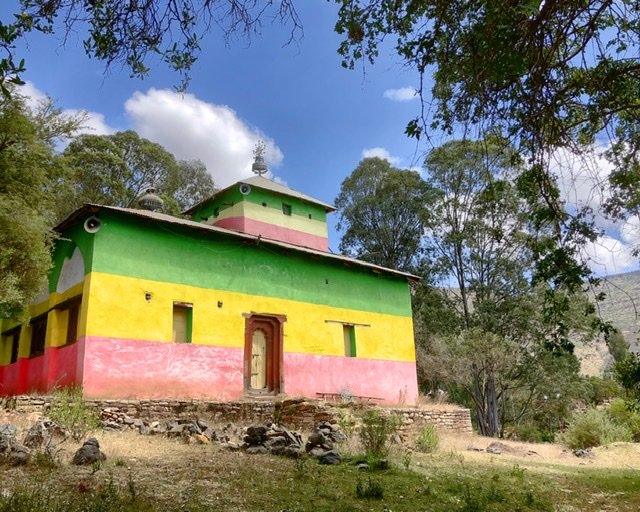
Hiking past eye-catchingly colorful churches trimmed with colors the Ethiopian flag. No separation of church and state here!
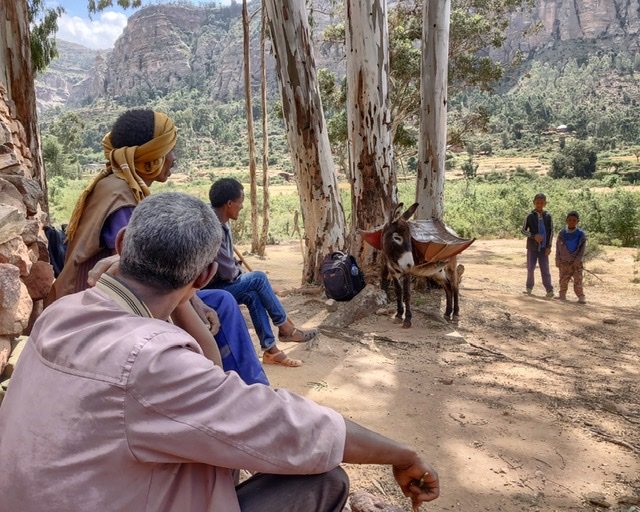
Donkey trade!! This was one of the transition points where we changed donkeys and porters. We did this daily, so that the porters never had to go too far from their villages.
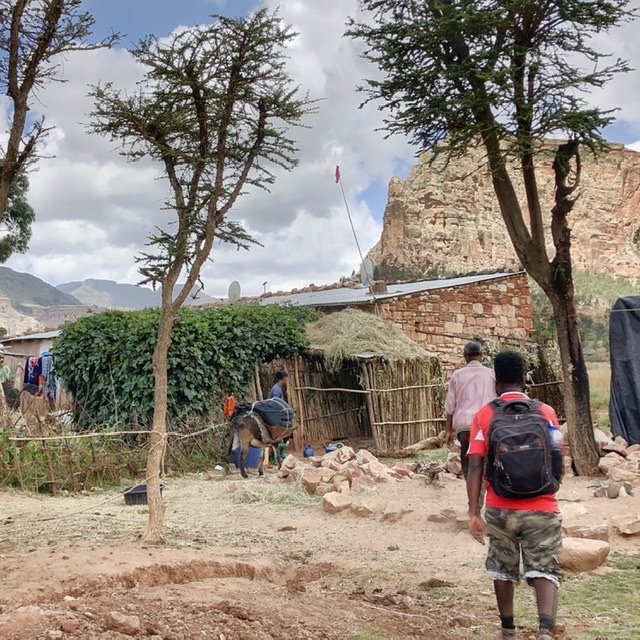
We were surprised and quite excited to learn that a traditional “home brewed” beer is made in many rural Ethiopian villages. Our guide for the trek, Solomon, certainly honed in on our enthusiasm in tracking down some for us. In most villages, a red flag is raised over a home “brewery” signaling the “tella” beer was ready. No flag… no drink. So marvelously medieval!
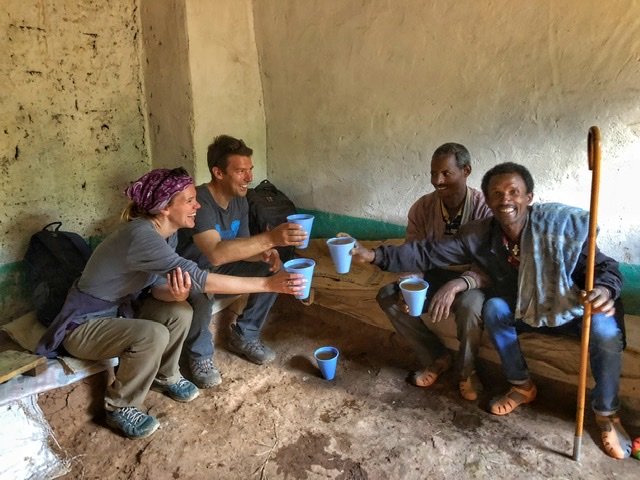
This ancient and uniquely Ethiopian fermented brew is made mostly with barley but wheat, maize, sorghum, and of course teff grains are also added along with something called “gesho”, which is something like a bittering herb that seems to act as hops do in beer. It is fermented in just 3-5 days, low in alcohol at between 2 and 6%. The tella has a distinct lactic acid sour twang flavor. Almost, like sourdough bread with a beer that is probably very close to what would have been brewed a thousand years ago.
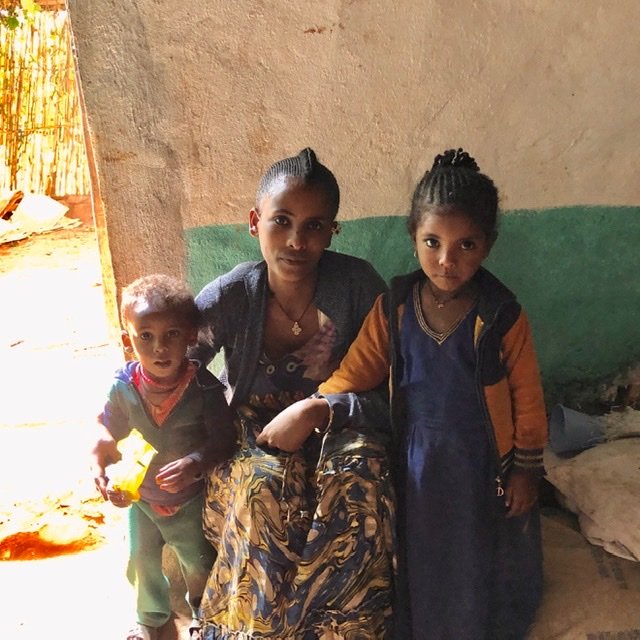
Not incidentally, the brewers are also ALWAYS female. She poses with her two little girls.
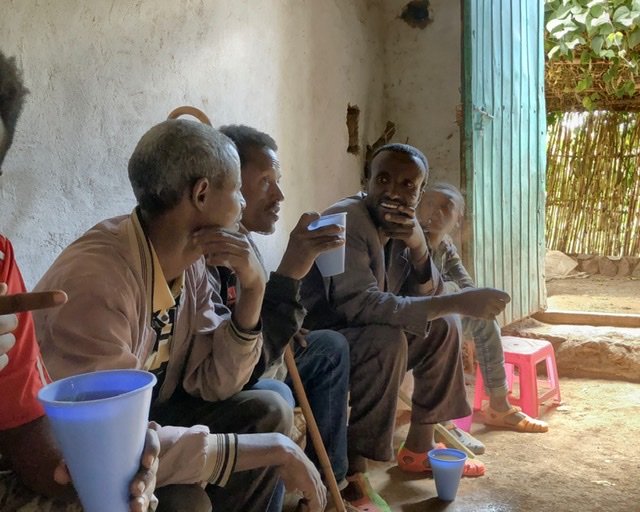
Cups topped up, we cheered with our guide, porters, and a few random villagers inside the brewery, a bare earth floor and stone walls combined with a few large plastic drums holding the tella, and characteristic Ethiopian furnishings including Jesus posters and a TV blasting the predictable shoulder-quaking, nails-on-a-blackboard melodies of Ethiopian pop. Tella, would definitely be an acquired taste for most, but reasonably quaffable for $.30 a cup, and you can’t do better than to drink it in this atmosphere!
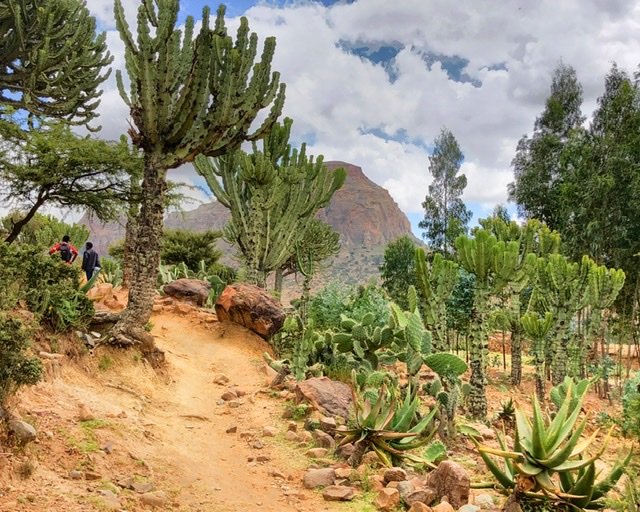
Some of the terrain we encountered on the trail. This particular section reminded us of Joshua Tree NP in California.
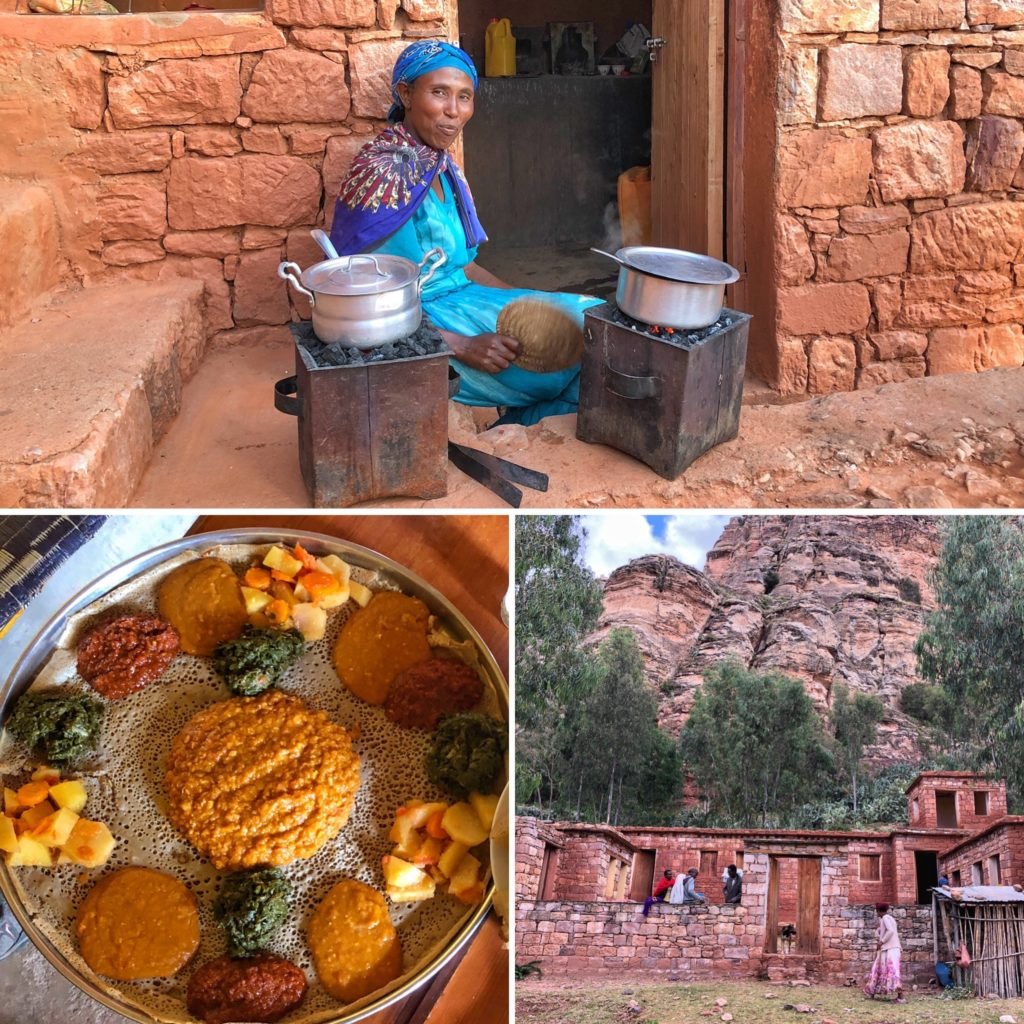
At one of the trekking camps we stayed at (all somewhat similar in design), one of the village ladies prepares our meals. Meals were massive, extravagant for what little equipment was on hand, and simply delicious. Every meal was chockfull of lentils, potatoes, greens, and spicy berbere (roasted ground red pepper) sauce, of course over ubiquitous injera, the spongy semi-fermented bread used in place of utensils. Besides being delicious, and all vegetarian, it’s extremely healthy eating.
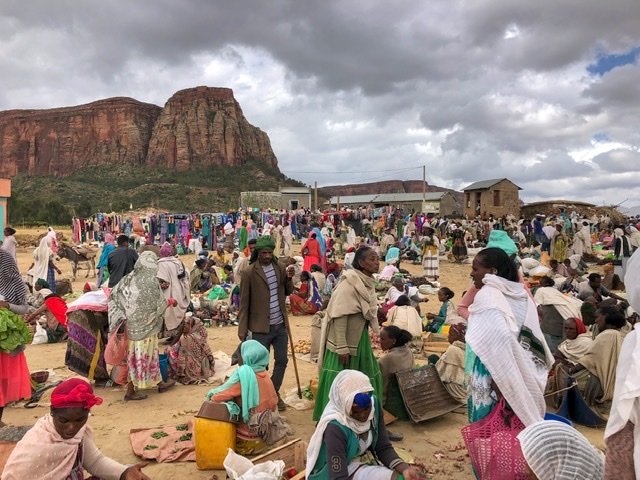
We were lucky to time our hike with the Saturday village market. People from far and wide attend this market, oftentimes walking for miles to both buy and sell fruits, vegetables, grains, clothing, and livestock. Aside from the modern clothing, this market seemed like a living museum, of how markets had been before modern manufacturing came into the picture.
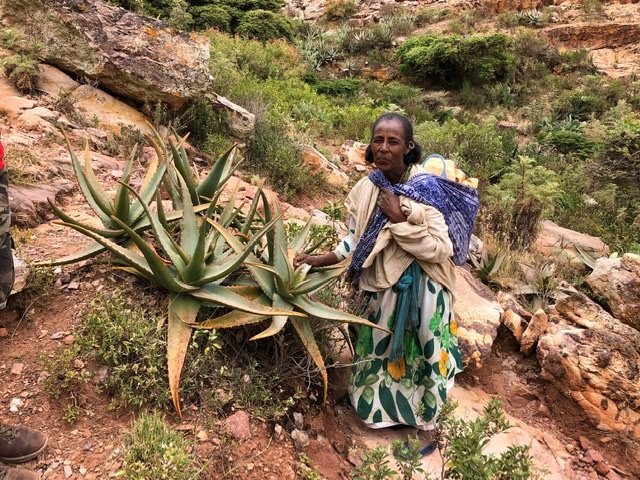
One lady in her sixties we met far up on our vertical ascent up the mountainside makes the jaunt twice or more a week as a commute, hauling a large sack of purchases on her back. The unreal endurance and will of these people, even at that age, is remarkable.
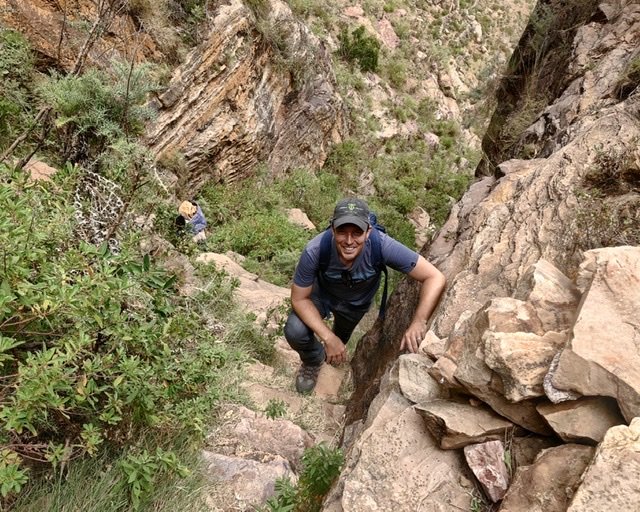
Speaking of that vertical mountain, we got to have a go at it too because this is where our third night’s stay was.
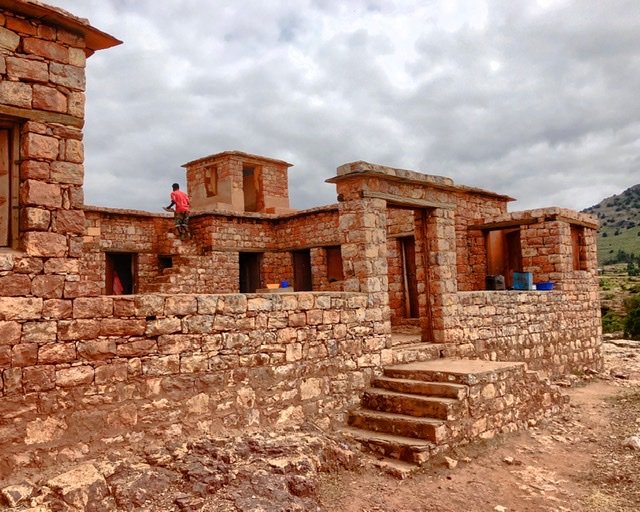
Outside of one of the lodges we stayed in. All of them had a “viewing platform” at the top where we often had meals.
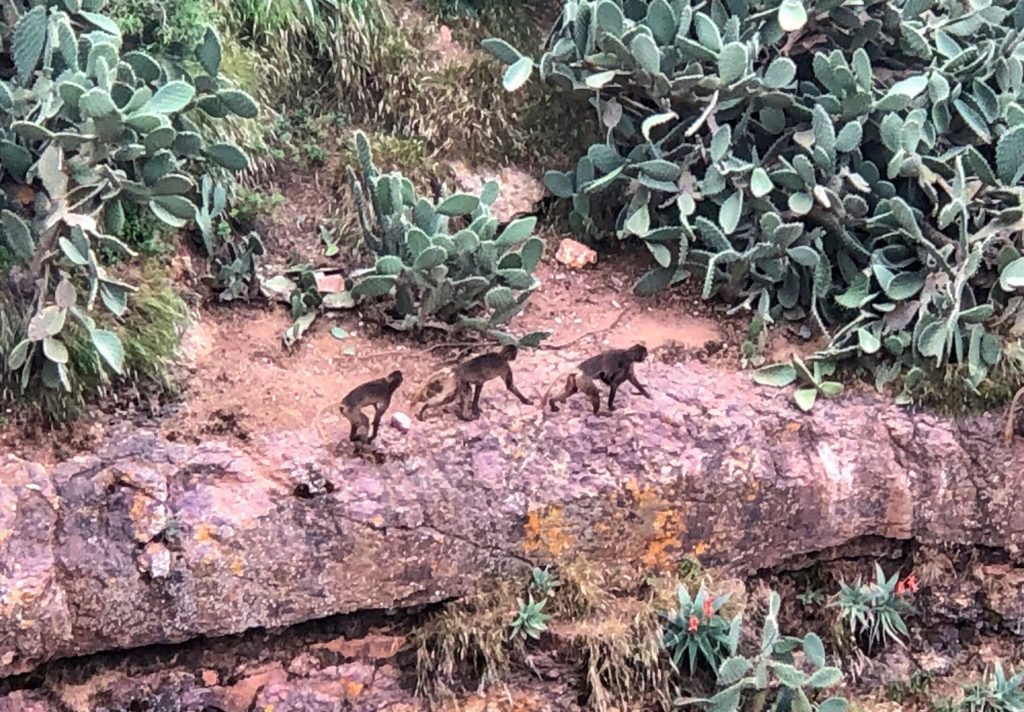
We also got to observe the gelada baboon in its natural habitat, but were highly disappointed when we saw the villagers chase the monkeys off and throw rocks at them because the monkeys are notorious for stealing their crops, which are obviously the lifeblood of the entire community. It’s just a sad reality of man vs. wild.
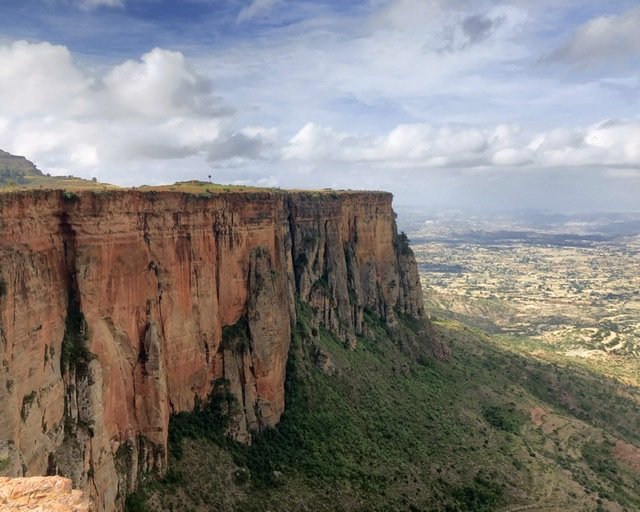
The vertical mountain we climbed early to get to our lodge on a plateau.
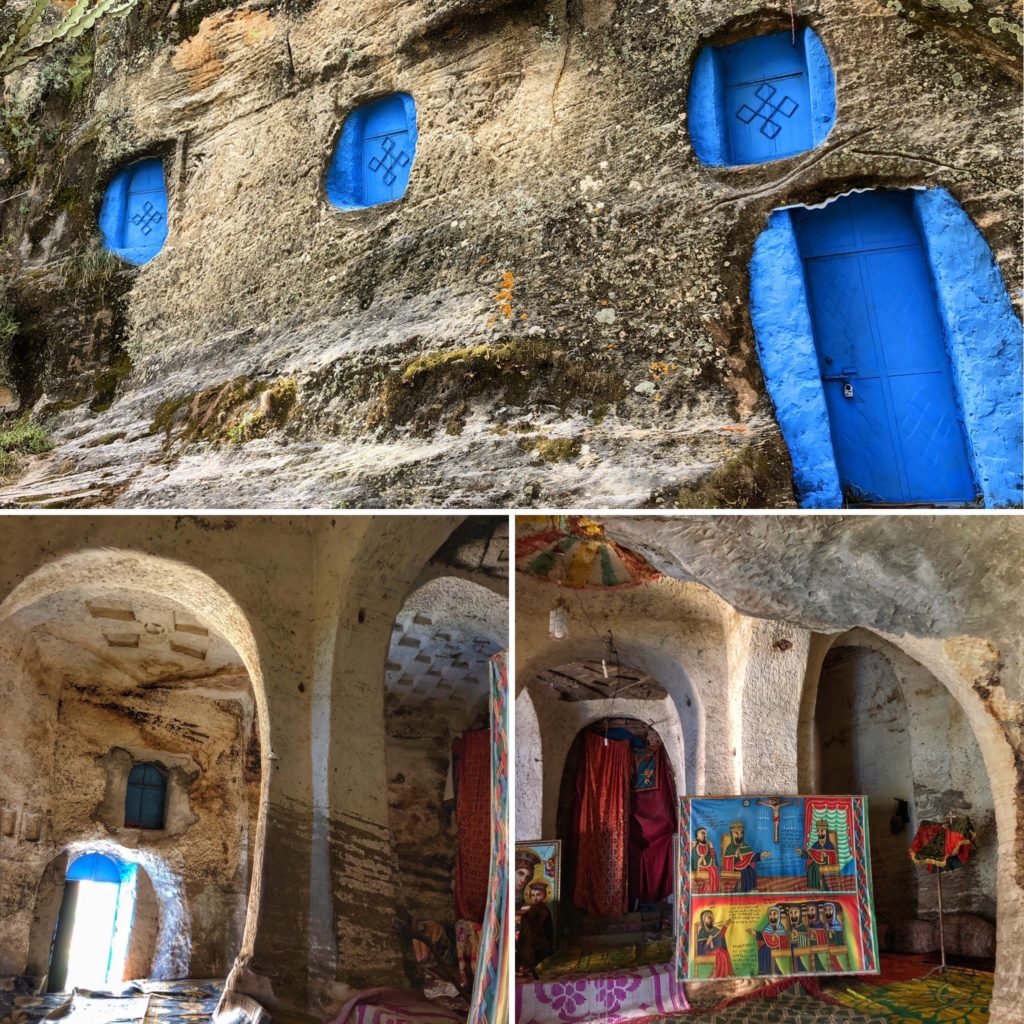
There are many ancient stone churches built into the rock within Tigray. We got the chance to visit one of them that was reputedly built in the 4th century. It started with the porter practically yodeling down three mountainsides to try and contact the priest, who needed to come to the church to unlock it and give us a tour. It was a steep $5 entry fee, but, it went to a good cause, like church preservation and the trek itself. The interior of the church is simple, yet much larger than you would expect. The church was carved out of the rock for defensive as much as for religious reasons. During Islamic incursion into Ethiopia many precious relics were hidden inside, and beneath false floors. Mass is still incredibly held in this church every Friday.
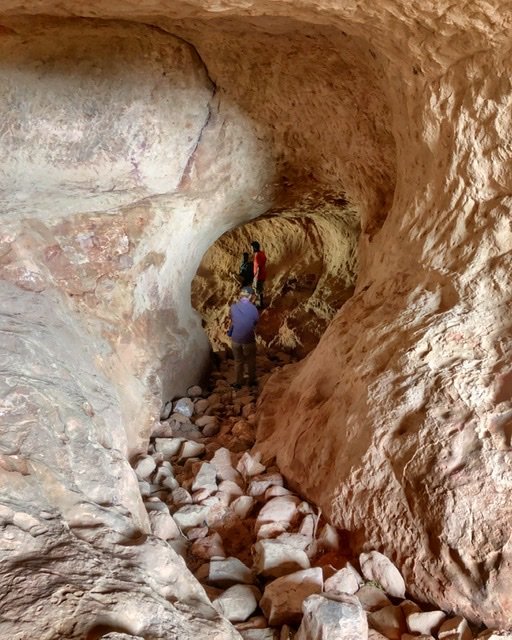
This tunnel was cut by hand using rocks or very basic tools in the 4th century to connected two village towns with churches. Absolutely astounding.
In fact, these whole treks were. We’re so glad we stepped off the beaten path into this one-of-a-kind country.


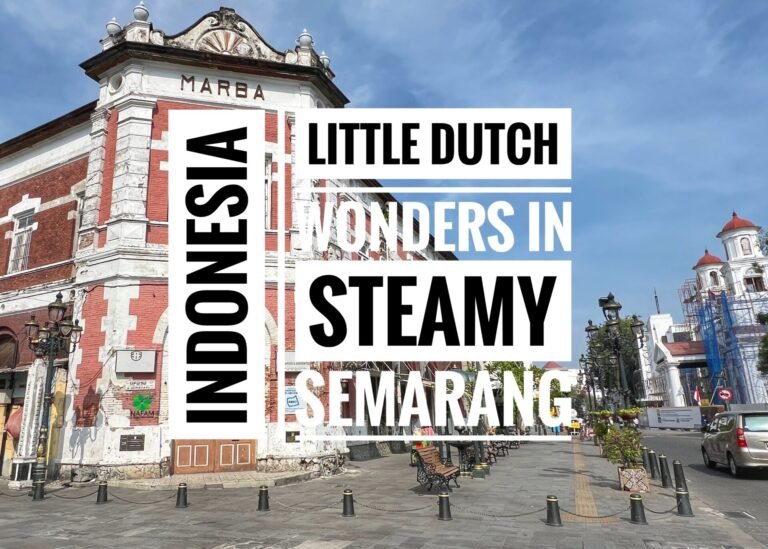
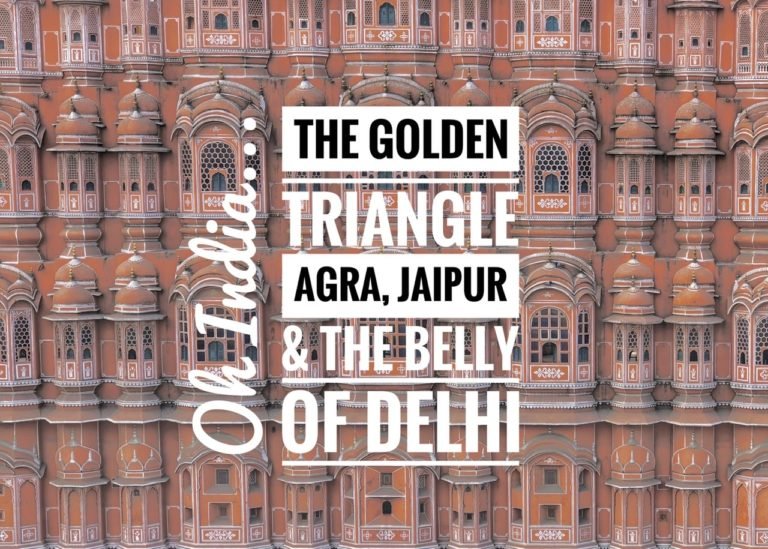
These blogs are very interesting, informative and easy to feel like you’re almost there too. Awesome experiences and fantastic photography throughout. I am proud of you both for preparing these!
Wow! Thanks so much for the kind words, and for following along. We’re glad to have you tagging along with us 🙂